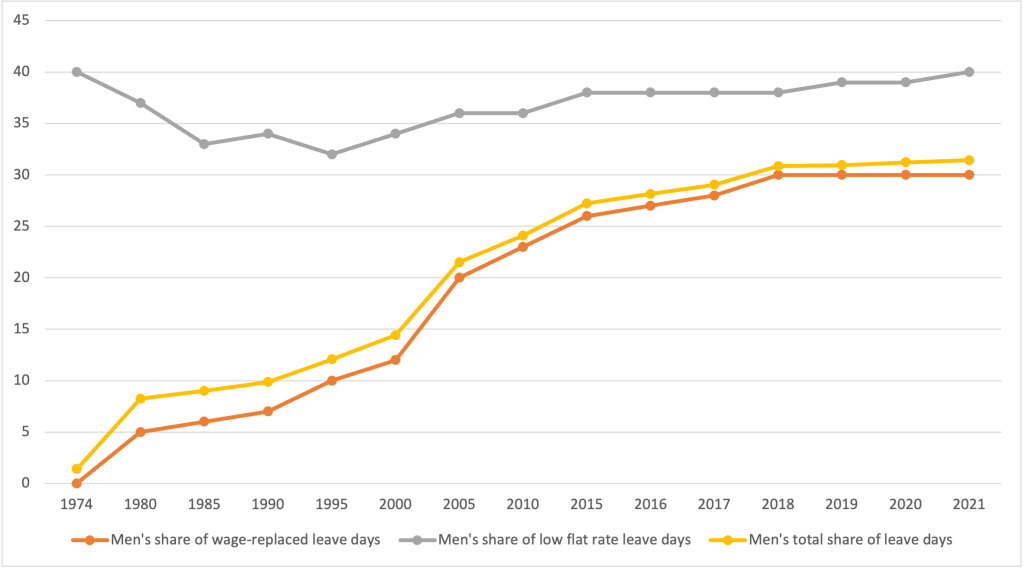What is the evidence on the Swedish “paternity leave” policy?
Since 1995, Sweden has earmarked an increasing number of parental leave days to each parent, creating a strong incentive for fathers to increase their (traditionally low) parental leave uptake. The literature on the causal impacts of these policies establishes several important findings. First, the incentive seems to work, as fathers tend to increase their uptake of paternity leave. However, who responds to the incentive, the timing of the leave and how mothers adjust to it is heterogenous, depending on the policy design and the underlying couple characteristics. Second, there is no strong support in the data for the argument, popular in public opinion and among policy-makers, that paternity leave should improve the balance of childcare duties within a couple and ultimately enhance women’s labor market position. However, in order to estimate causal effects, the studies reviewed in this policy brief focus on the first cohort of families affected by earmarked parental policies, whereas impacts on mothers’ labor market outcomes are more likely to manifest in the long run. Further, paternity leave policies in the broader sense have benefitted mothers’ health post childbirth and they may also have broken the social stigma on fathers taking time off to care for their children. Finally, recent evidence suggests that earmarking has improved gender attitudes in the next generation, making men less likely to hold stereotypical views about gender roles in society.
Parental leave in Sweden
All parents in Sweden have been entitled to paid parental leave benefits since 1974, with no difference between birthing and non-birthing parents (for simplicity referred to as mothers and fathers henceforth). Despite this, fathers’ parental leave take-up has historically been very low (see Figure 1).
To change this pattern, the legislator has introduced a few reforms over the years. In 1995, 30 of the wage-replaced days (i.e. parental leave days compensated at almost the rate of the daily wage) were earmarked to each parent, creating the so called ”mum/dad month”. When a parent failed to take up these 30 days these would be “lost”, as earmarked days could not be transferred to the other parent. Through two subsequent reforms, effective from 2002 and 2016 respectively, the number of earmarked wage-replaced days increased, first to sixty days and then to ninety days.
Today, the total allowance is 480 benefit days, of which 390 are wage-replaced (paid at about 80 percent of the parent’s wage), and the remaining 90 are compensated at a low flat rate (approximately 15 euros per day). 90 of the wage-replaced days are earmarked to each parent. The parental leave days can be utilized until the day the child turns 12 or until the child finishes 5th grade, but 80 percent of these days must be used by the time the child turns 4.
As shown in Figure 1, father’s share of the total parental leave steadily grew over the years when the earmarking reforms occurred but has since 2018 stalled at a rate of 69/31 (i.e., mothers and fathers take 69 and 31 percent respectively of the total number of leave days claimed in Sweden during one year).
Figure 1. Men’s share of parental leave days in Sweden, 1974-2021, in percent.

Source: Author’s compilation based on data from Statistics Sweden.
One could speculate, based on these trends, that earmarking might have successfully increased father’s take-up of parental leave. However, without rigorous statistical analysis, it is virtually impossible to distinguish between the role of the earmarking polices and secular trends in preferences over parental leave. Thankfully, a few papers have studied the Swedish parental leave reforms, using state-of-the art techniques to understand their respective causal impacts. What is the research-based evidence on the Swedish parental leave earmarking reforms? Did they successfully incentivize fathers to increase their take-up? Did they succeed in their broader goal of balancing child responsibilities within couples, ultimately helping women improve their position in the labor-market? How were children affected by them? What lessons from the Swedish experience can be useful for fine-tuning of the Swedish policy or for similar designs in other countries?
This policy brief delves into the academic literature on the impacts of the Swedish earmarking reforms. The review is by no means representative of the large amount of academic work produced on the Swedish parental leave reforms. Rather, it is a small selection of studies where results can be more easily interpreted as causal impacts, as they are based on comparing families with children born just before versus just after the relevant date for the policy implementation, and account for so called month-of-birth effects (see e.g. Larsen et al., 2017) when needed. Causal estimates can be more directly used to inform policy-making, which is what motivates the focus of this review.
Earmarking and take-up of paternity leave
As explained above, the Swedish earmarking system creates strong incentives for fathers to increase their take-up of leave days, as these would otherwise be “lost”, leaving couples with the need to resort to potentially more costly arrangements for childcare.
It is thus not surprising that the 1995 reform increased fathers’ take-up of wage-replaced leave by an average of 15 days, 50 percent of the pre-reform take-up (Ekberg et al., 2013). This change seems to mostly stem from the 54 percent of fathers who were taking 0 days of leave before the reform and were induced to take between 20 and 40 days after, so that the percentage of fathers not taking any leave declined to 18 precent.
In a recent working paper, Avdic et al. (2023) complement this evidence, considering all leave days together. They show that the reform induced fathers to increase their take-up of total parental leave by 21 days, whereby mothers decreased it by the same amount. Therefore, on average, the total amount of leave taken by Swedish parents remained unchanged, but the mother’s share decreased by about 5.4 percentage points. The paper also compares changes in parents’ take-up month-by-month, finding that some mothers took some unpaid leave within the child’s first year to compensate for the loss of wage-replaced days. It is not clear why these mothers would not resort to the low flat rate leave, as other mothers seem to have done (see Ekberg at al., 2013). In general, the data points to fathers having mostly, although not exclusively, substituted for mothers’ time with the child during the child’s second year of life.
Avdic and Karimi (2018) extend the policy-evaluation to the 2002 reform, which earmarked one additional month to each parent, but also made one more month of wage-replaced leave available. They find that this reform also caused an increase in take-up of paternity leave, but for a different group of fathers. While in 1995 fathers that otherwise would have taken no leave were induced to take approximately one month, the 2002 shift occurred mostly among fathers who, instead of taking between 30 and 40 days of leave, started taking more than 50 days.
These findings are consistent with those in Alden et al. (2023), who study the characteristics of fathers who do not take any leave. They find that while the 1995 reform changed the composition of this group of fathers, the same thing did not happen with the 2002 and 2016 reforms. Over-time, one group of men consistently stands out for not taking any parental leave regardless of the incentives created by the legislator, namely fathers with worse labor-market positions, and whose earnings are lower than that of the mothers.
Paternity leave and gender gaps
The main motivation for policies that seek to increase the take-up of parental leave among fathers is that this increase can help women, especially high-skilled ones, improve their labor-market position (Ekberg et al., 2013). The economics literature has long established a systematic loss in earnings and employment for women following the birth of their first child (the so-called child penalty; see e.g. Kleven et al., 2019). There are two main mechanisms through which earmarking policies could improve women’s labor market outcomes. First, if firms discriminate against women because of the (perceived) cost of maternity leave, the discrimination should decline once employers expect also men to take parental leave. Ginja et al. (2020) show evidence (although not causal) consistent with long maternity leaves reducing child-bearing aged women’s “attractiveness” among Swedish employers. Second, by creating a stronger bond between fathers and children, and by reducing mothers’ specialization in childcare, paternity leave should increase the time fathers allocate to childcare as the child grows up, thus re-balancing the division of non-market (and possibly market) work within the couple.
As pointed out in Cools et al. (2015), the first type of effect, more likely to be relevant in the long run, is hard to estimate with data from only one country, as virtually all employers in the country should be somewhat affected by the change in perceptions.
Instead, Ekberg et al. (2013) study the effect on intra-household division of childcare responsibilities, by estimating the impact of the 1995 reform on the amount of time that fathers and mothers claim off work when their child is sick. They find no evidence that the 1995 reform increased the share of time off taken by fathers to care for sick children. Consistently, the study also fails to find evidence of large and robust changes in mothers’ earnings for thirteen years post childbirth. Similarly, Avdic et al. (2023) show that mothers affected by the 1995 reform did not increase, on average, their labor supply, except during the first year of the child’s life.
While these analyses are extremely valuable for our understanding of the reforms’ effects on the first cohort of families affected, they fall short of capturing long-term dynamics. For instance, it is important to acknowledge that the decision on who takes time off when the child is sick depends on many factors, including the availability of flexible arrangements at work. Women are known for selecting into occupations and jobs that allow a more flexible schedule (Goldin, 2014). This pattern might change if the increase in take-up of paternity leave leads to updated expectations among women on partners’ willingness to share daycare responsibility. This is most likely a long-term development, which the design used in the above outlined studies does not capture.
Another effect of the Swedish parental leave system, not directly linked to earmarking but nevertheless indicative of the importance of fathers’ time off work during the child’s first year of life, is that on mothers’ health. Persson and Rossin-Slater (2019) show that a Swedish 2012 reform that in practice allowed fathers to take 30 days of parental leave in concomitance with the mother during the child’s first year of life reduced the likelihood of mothers experiencing health issues due to post-partum complications.
An important aspect that the literature has so far not emphasized is also that earmarking reforms might affect another gender gap, namely the “freedom” to take the leave. Given the traditional division of roles across genders, there might be a stigma at a societal level against men taking parental leave. By creating strong economic incentives for taking paternity leave, the earmarking policies may downplay the stigma in the short-term and break it in the long-term. There is some suggestive, although not definitive, evidence that norms around paternity leave might have changed. Avdic and Karimi (2018) show that between 1995 and 2002 the share of fathers who were taking more than one month of leave had already started increasing before the second month was earmarked. More research would be needed, however, to assess the role of policies in changing societal perceptions around paternity leave.
Paternity leave and children’s outcomes
An obvious question to ask is how children are affected by earmarking of parental leave days. Avdic et al. (2023) study this question in the context of the 1995 reform. By looking separately at different groups of children by sex and parents’ education, they find that the 1995 reform caused a decline in GPA for sons of non-college-educated fathers and mothers. The most likely channel for this relationship, according to the authors, is boys’ diminished access to fathers’ time, due to the 1995 reform increasing the likelihood of couple dissolution within the child’s first three years of life (for households with low-earning mothers). At that time children tended to live predominantly with the mother in case of parental separation. However, a potential additional channel could be the worsened economic situation caused by the paternity leave. In households with low-earning mothers, mothers’ and family earnings declined post-reform due to mothers compensating for “lost” leave days by taking unpaid leave. Very conflictual separations could also be behind the effect on children’s GPA.
These findings highlight the importance of considering potential unintended consequences of the parental leave policies, and the diverse effects they might have on different demographic groups. Such considerations could improve the design of future policies. For instance, Avdic and Karimi (2018) find that the 2002 reform, which earmarked one more month and added one month of wage-replaced parental leave, did not cause couple dissolution. Thus, the authors conclude that not imposing strong constraints on households, while creating incentives for fathers to take paternity leave, is highly desirable.
Finally, in a very recent working paper, Fontenay and Gonzalez (2024) consider the effect of earmarking policies on children’s gender attitudes as adults, leveraging data from online surveys of 3,000 respondents across six European countries, including Sweden. They study changes in attitudes as measured by an Implict Association Test, which is meant to capture subconscious associations between women and family and men and career. In five of the countries studied they find that male respondents born soon after an earmarking reform have less stereotypical gender attitudes than those born before. No differences are detected for women. The effect in Sweden is one of the largest: in a sample of 237 male respondents, the father being eligible for the “dad-month” makes the child hold more egalitarian gender-attitudes as an adult by 0.3 standard deviations. The authors suggest that a role model effect might be at play, whereby boys who observe their fathers being more involved in childcare are nurtured to hold more egalitarian beliefs about gender roles.
Conclusion
Since 1995, Sweden has earmarked an increasing number of parental leave days to each parent, creating strong incentives for fathers to increase their previously very low parental leave uptake. This policy brief has reviewed the literature that studies the causal impacts of these earmarking reforms, highlighting a number of important conclusions as well as gaps in the knowledge on the effects of these policies.
First, the incentives created by the earmarking policies seem to work, as fathers tend to increase their uptake of paternity leave, while mothers tend to increase their labor supply during their child’s first year of life. However, such effects are heterogeneous, depending on the policy design and the underlying couple characteristics. Designs that impose strong constraints on household choices seem to have adverse effects on low-income or low-education households, reducing mothers’ earnings, triggering couple dissolution, and negatively affecting children’s GPA. Future increases in earmarking or similar policies in other countries should consider these design details carefully.
Second, there is no strong support in the data for the argument, popular in the public opinion and among policy makers, that paternity leave improves the balance of childcare duties within a couple and that it ultimately enhances women’s labor market position. However, to estimate causal effects, the studies analyzed in this policy brief focus on the first cohort of families affected by the earmarked reforms, whereas impacts on mothers’ labor market outcomes are more likely to be seen in the long run. After all, Sweden is one of the countries with the lowest documented child penalty in employment and earnings (see the child penalty atlas), and it is unlikely that policy played no role in narrowing gender gaps among parents. Consistently, recent evidence suggests that earmarking has improved gender attitudes in the next generation, making men less likely to hold stereotypical views about gender roles in society.
Further, it is important to mention that paternity leave policies in general have benefitted mothers’ post-childbirth health and that they may have broken a societal stigma around fathers taking time off to care for their children.
References
Disclaimer: Opinions expressed in events, policy briefs, working papers and other publications are those of the authors and/or speakers; they do not necessarily reflect those of SITE, the FREE Network and its research institutes.
Photo: Iolanda Photography, Shutterstock




